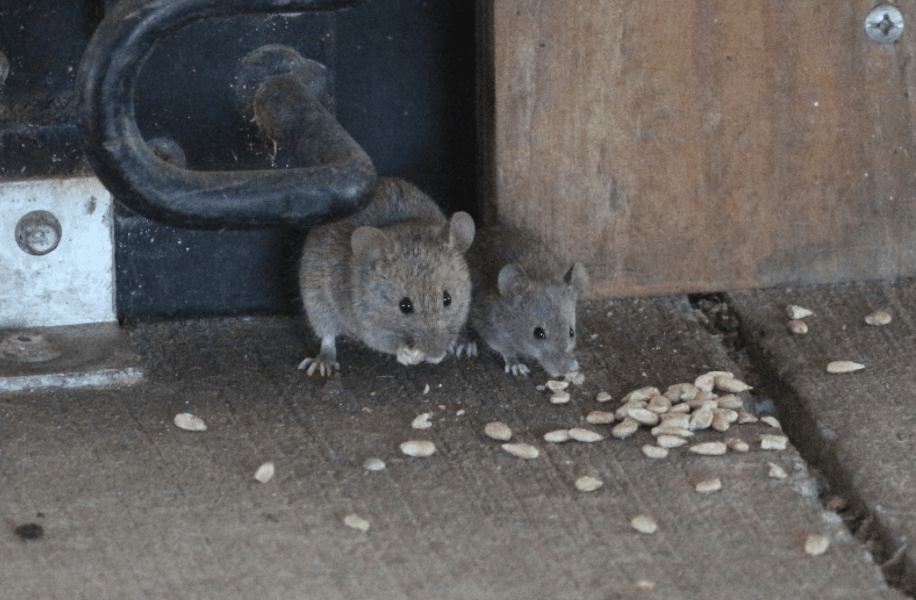Mice can get into homes and become a real problem—building nests, contaminating food, causing damage, and spreading disease. To get rid of them, you need to understand what they do and what they like. Trapping and removing them is usually the best DIY method for controlling a mouse problem. Poisoning mice puts children and pets at risk. At the other end of the spectrum, failing to get rid of mice in the home can lead to large populations inside the house.
1. How Do You Know If You Have Mice?
Although the most obvious sign is actually seeing live or dead mice in your home, there are plenty of other signs that can tell you a mouse infestation may be building. These include:
- Gnawed holes in stored foods, piled papers, insulation, etc.
- Food scraps or wrappings left behind, especially in out-of-the-way places, such as inside shoes or boots or in the corners of closets and cabinets.
- Droppings or tiny hairs.
- Runways—narrow pathways where dust and dirt have been swept clean, noticeable grease marks, or urine trails can be seen under a black light.
- Nests or piled nesting materials.
- Skittering or scratching sounds coming from wall, ceiling, or floor cavities.
- Stale, rank, or musty odors.
2. How Do You Know If It’s a Mouse or a Rat?
There are key differences between mice and rats. Mice are much smaller than rats. Adult mice are about 7 1/2 inches in length, including the tail. The most common rats in the United States are the Norway rat and the roof rat. They are about 14 to 16 inches in length, with tail length varying by species.
3. What Do Mice Eat?
Mice prefer to eat cereal grains and plants, but they will feed on almost anything. They are very commonly drawn to dried (and bagged) stored food, including pet food.
4. How Long Do Mice Live?
A house mouse will rarely live more than a year in the wild, but in a protected environment with food and water (such as a home), it can live up to three years.
5. Do You Keep Finding Shredded Paper and Black Rice-Like Things?
If you encounter shredded paper, you have likely found a mouse nest. A mouse will build its nest from just about any soft material or finely shredded paper. And the little black “rice” is most likely mouse droppings.
6. Where Should You Put Mouse Traps?
Mouse traps should be placed where the signs of mice have been found—shredded paper or cloth, droppings, urine stains, and gnawed items. Traps are available from home and garden stores or even some grocery stores.

7. What If Your Traps Aren’t Working?
Mice are very curious and will investigate new things. So, if they are not caught within the first days of trap placement, the trap (or bait) is probably in the wrong place and should be moved. Be sure to place the trap where any signs of mice are seen or where food or water is available. If you are worried about the problem becoming a bigger issue it is best to call a local pest control company.
8. What Is the Best Bait for Mouse Traps?
Contrary to popular belief, cheese is not the best bait to use in traps. Mice are more attracted to peanut butter, but it needs to be replaced if it gets too dry or hard. Mice are also attracted to bacon, nuts, dried food, and sticky candies. The bait should be securely attached to the trap trigger so the rodent can’t simply pluck it off and walk away. Often, a small amount of peanut butter worked into the crevices or cup of a trap is the most effective bait. Mice are attracted to the smell and will have to work to get the food out of the bait, setting off the trap.
9. Why Are You Not Seeing the Mice?
Mice are nocturnal creatures, so they are most active between dusk and dawn. They don’t usually like bright lights, but a mouse may sometimes be seen during the day, especially if its nest has been disturbed or it is seeking food. Seeing them in the day also can indicate a large infestation in a home.
10. How Quickly Do Mice Breed?
In a single year, one female mouse can breed up to 10 litters of five to six young. These 60 offspring can begin to reproduce themselves in as little as six weeks. So within months, you could have a huge population of mice.
11. How Do Mice Get Inside a Home?
A mouse can slip through holes and gaps as small as 1/4 inch, or roughly the size of a pencil. And if an opening is not big enough to squeeze through, the mouse can gnaw it until it is big enough. Mice also can jump 13 inches high and can run along wires, cables, and ropes. They are excellent jumpers, swimmers, and climbers and can scale rough and vertical surfaces.
12. What Can You Do to Get Rid of Mice in Your Home?
There are a number of methods of control, including traps, baits, rodenticides, and Hilton Head Exterminators Rodent Exclusion Department. It’s also a good idea to seal openings around pipes, roof vents, and other potential entry points.
If you find traps are not working effectively, trust our trained exclusion department to catch and relocate any mice, squirrels, and raccoons from your home.

